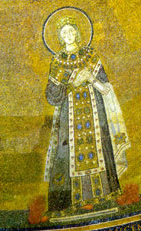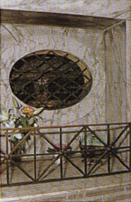 |
"Directly behind the altar is a statue of Saint Agnes, fashioned out of an ancient Roman work of yellowish oriental alabaster shot through with agate. It is now known to be an ancient copy of a female figure found at Herculaneum and kept today in the Dresden museum. Nicholas Cordier, a French artist working in Rome and known to Italians as "il Franciosino" (the little Frenchman), was asked by Pope Leo XI in 1605 to turn the fragment of the statue into an image of the saint...The anglican clergyman Conyers Middleton was sufficiently unnerved by this figure to be convinced, in 1729, that it represented Dionysus, who, he believed, continued to be worshipped in Rome under cover of the name of Saint Agnes." (p.79) |
"Beneath the altar lies the body of Agnes; her soul is depicted in the apse mosaic above, already with God. She stands tall and regal, an adult rather than a child." (pp. 96-104)
|
"The apse enfolds the altar and its canopy. Its rounded, expanding hollowness provides an 'endless' end to the wayfarers' journey represented by the nave. In the mosaic covering the quarter-sphere above, Agnes and her two companions stand out against a field of plain, gleaming gold, signifying eternity and the Heavenly Jerusalem that is the world's destiny. For each visitor to the church, this flood of gold is the lux perpetua that Christians hope all will enjoy beyond death..." (p.96) |
 |
The altar, with its ciborium (pp. 89-95) and the carving of the Holy Spirit (pp. 74 and 94), supported by four porphyry columns (p. 77) and the statue of St Agnes behind it (p. 79).
The arrangment of the church's sanctuary has now been changed, in accordance with the decisions of Vatican II. The priest now says Mass facing the congregation. The statue of Saint Agnes has been moved back from the altar to the apse wall, the tabernacle is in a side chapel, and the balustrade in front of the altar has been opened."
|
 |
|
 |
The body of Saint Agnes lies under the altar, together with that of her milk sister Saint Emerentiana.
|
|
Seventh Century gold mosaic of Agnes with a Pope on either side.
|




